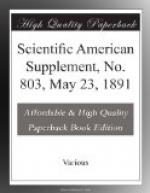An improved method of testing Portland cement has been adopted by M. Deval, Chief Superintendent of Bridges and Roads, who has charge, under M. Saele, of the Public Works Laboratory of the City of Paris. The principal difference in M. Deval’s method consists in the use of hot water for the period of hardening. The briquettes are made in the usual way, and of the ordinary size; and the cement to be tested is gauged with three times its weight of normal sand, and the smallest quantity of water possible. After preparation, the briquettes are allowed to harden in air for a period ranging from 24 hours for Portland cement to 30 days for certain slow-setting hydraulic limes. After this period, the samples are immersed in water kept at a temperature of 80 deg. C., in which they remain for from two to seven days. The briquettes are then broken in the ordinary way. After careful comparisons of many varieties of cement hardened hot and cold, M. Deval finds that cold tests are fallacious, inasmuch as they may fail to detect bad material. Portland cement of good quality will not only stand water at 80 deg. C., but will attain in seven days about the same strength as is reached in the cold after 28 days. The hot test therefore saves time. The hot test is an unfailing proof for free lime; cements containing this constituent betraying weakness, and cracking, swelling, and disintegrating in a very significant manner. This last result is regarded as a valuable quality of the new method of testing cement, the general effect of which appears to be to enhance the test value of really good cements, while depreciating those of an inferior character.
* * * * *
THE SCIENTIFIC AMERICAN Architects and Builders Edition
$2.50 a Year. Single Copies, 25 cts.
This is a Special Edition of the SCIENTIFIC AMERICAN, issued monthly—on the first day of the month. Each number contains about forty large quarto pages, equal to about two hundred ordinary book pages, forming, practically, a large and splendid Magazine of Architecture, richly adorned with elegant plates in colors and with fine engravings, illustrating the most interesting examples of modern Architectural Construction and allied subjects.
A special feature is the presentation in each number of a variety of the latest and best plans for private residences, city and country, including those of very moderate cost as well as the more expensive. Drawings in perspective and in color are given, together with full Plans, Specifications, Costs, Bills of Estimate, and Sheets of Details.
No other building paper contains so many plans, details, and specifications regularly presented as the SCIENTIFIC AMERICAN. Hundreds of dwellings have already been erected on the various plans we have issued during the past year, and many others are in process of construction.




